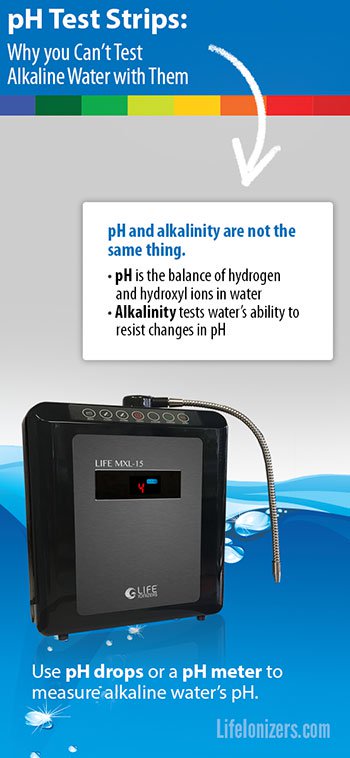One of the most commonly asked questions about alkaline water from a water ionizer is: Why can’t I get an

accurate pH reading with pH test strips? The reason is that pH test strips are designed to test alkalinity and pH, not just pH alone. Many people think that pH and alkalinity are the same things, but they’re not:
-
- pH is the balance of hydrogen and hydroxyl ions in water
- Alkalinity tests water’s ability to resist changes in pH
pH test strips don’t give water ionizers full credit for their effect on water pH
The pH level of alkaline water can be tested in one of two ways: Either by using pH drops, or a pH meter. What pH strips are actually measuring is the effect on pH that the alkaline minerals in water have on water pH. The problem with this is: Those minerals aren’t the only thing raising the water’s pH. Particles called hydroxyl ions also raise water pH. Those hydroxyl ions are responsible for some of the most important health benefits of alkaline water
The mineral salts in tap water consist of alkaline minerals, mostly calcium and magnesium, and bicarbonate. pH test strips can measure the pH of tap water because tap water gets its pH from both the alkaline minerals in it, plus the bicarbonate. Both of these substances contribute to the water’s alkalinity and pH, the strips report water pH as a function of that alkalinity: The minerals and the bicarbonate give the water alkalinity, which raises its pH.
Water ionizers get rid of the bicarbonate and replace it with hydroxyl ions. The ionization process splits the minerals and bicarbonates in tap water apart. They are then discharged through separate ports. pH strips can’t measure the contribution to pH and alkalinity from hydroxyl ions. For that reason, you can’t test ionized alkaline water with pH strips.
Can you find hydroxyl-rich alkaline water like from a water ionizer in nature?
Yes, it is found in four places on Earth:
- Brandholz at Nordenau in Germany
- Hita Tenryosui in Japan
- Tlacote in Mexico
- Naldone in India
People have been traveling to those above springs for centuries to restore their health. Today, people by the thousands flock to those springs to improve their health. You can save a lot of money, time, and travel by simply buying a water ionizer. You can then make hydroxyl-rich alkaline water yourself.
The hydroxyl ion is why alkaline water is better for your health than plain water
The hydroxyl ion has a negative charge because it has an excess electron. Because of that, the hydroxyl ion acts as an antioxidant: It gives up its electron to harmful radicals like Superoxide Dismutase that cause premature aging and the development of disease. Research on the antioxidant properties of the hydroxyl ion in alkaline water in both mice and nematodes (a type of worm) suggests that alkaline water rich in hydroxyl ions has the potential to extend lifespans and may offer protection against some degenerative diseases.
Athletes benefit from the hydroxyl ion too
Clinical testing performed on athletes at the University of Montana and elsewhere reveals that hydroxyl-ion rich alkaline water has several benefits that can improve your workout:
- Reduces perceived effort when working out
- Reduces intra-muscular oxidation
- Improves hydration status
- Speeds recovery
Alkaline water + electrolytes make a potent sports performance beverage The antioxidant hydroxyl ion combined with electrolytes was shown in clinical testing to cause athletes to feel that it took less effort to perform a workout routine when they drank alkaline water with electrolytes compared to plain water. This reduction in perceived effort enabled the athletes to work out longer and harder. The athletes did not experience that same reduction of effort when they drank plain water mixed with electrolytes.
Author’s note: I use alkaline water mixed with electrolytes to improve my performance in both bicycling and in martial arts. It makes a difference I can feel in my workouts.
Clinical testing at the University of Montana revealed that alkaline water alone reduced intramuscular oxidation when working out. Intramuscular oxidation is what causes the burning sensation in your muscles when you exercise, and it reduces both strength and endurance.
Another study was done at the University of Montana also showed that alkaline water alone improves your hydration status while working out, and speeds your recovery after working out. Hydration is very important for top performance: Your athletic performance begins to decline with as little as 2% dehydration.
Use pH drops or a pH meter to measure alkaline water’s pH
To measure the pH of alkaline water accurately, you should use the pH drops supplied with your water ionizer, or use a pH meter. Either way, you’ll get an accurate reading. Use pH strips to measure the effect of alkaline water on your saliva and urine pH. Test your water and yourself the right way so you can make informed decisions on your health!
Got questions? We have the answers! Call us at 877 959-7977 for a free no-obligation consultation
References
Ostojic, S.M. “Al. Drinks with alkaline negative oxidative reduction potential improve exercise
performance in physically active men and women: double-blind, randomized, placebo-controlled, cross-over trial of efficacy and safety..” Serbian Journal of Sports Sciences. 5.3 (2011): 83-89. http://www.sjss-sportsacademy.edu.rs/archive/details/drinks-with-alkaline-negative-oxidative-reduction-potential-improve-exercise-performance-in-physically-active-men-and-women-double-blind-randomized-placebo-controlled-cross-over-trial-of-efficacy-and-safety-223.html
Heil, P and Seifert, J. Influence of bottled water on rehydration following a dehydrating bout of
cycling exercise. Journal of the International Society of Sports Nutrition Springerlink July 2009. http://www.springerlink.com/content/kn41764j65165u3x/fulltext.pdf
Heil, D. “Acid-base balance and hydration status following consumption of
mineral-based alkaline bottled water..” Journal of the International Society of Sports Nutrition. Journal of the International Society of Sports Nutrition, 13 Sep 2010. Web. 26 Mar 2014. <http://www.jissn.com/content/7/1/29>.